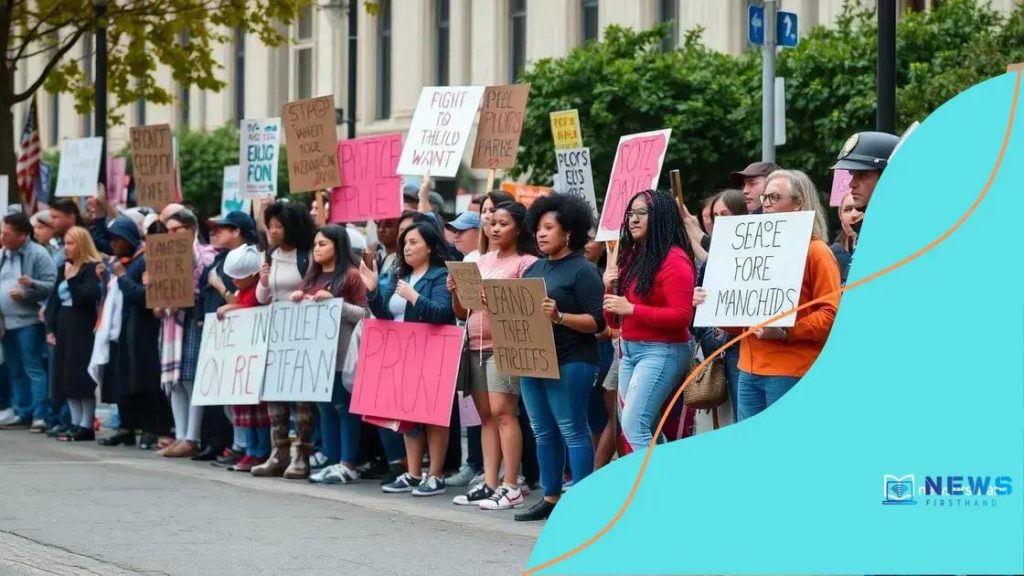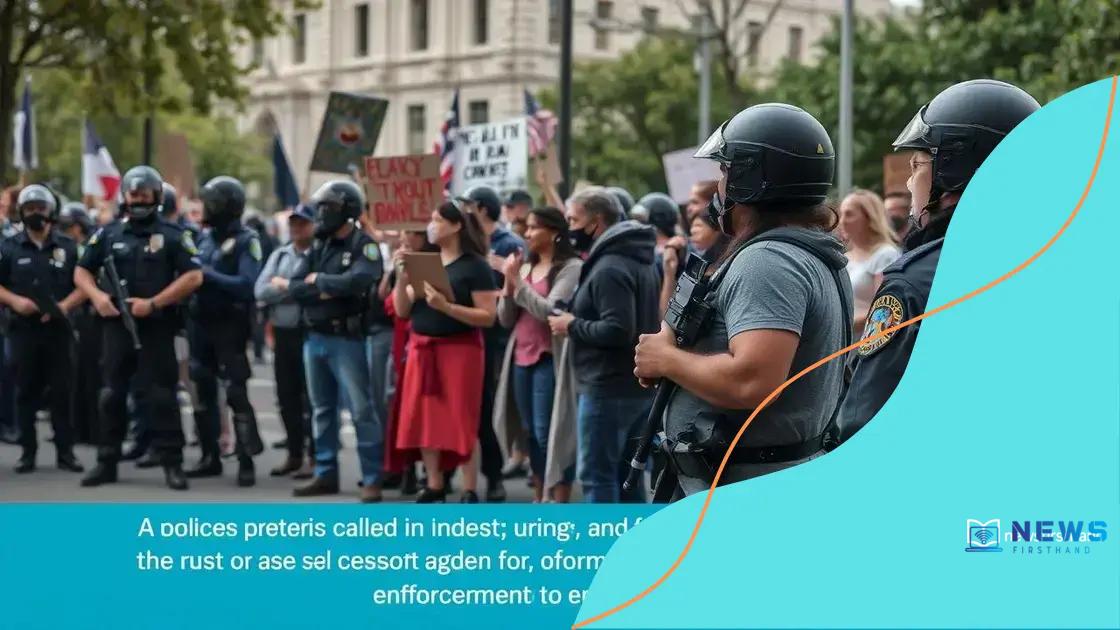Legal reviews of protest law enforcement: Are your rights protected?

Legal reviews of protest law enforcement evaluate existing regulations, ensuring they protect protesters’ rights while guiding law enforcement responses to maintain public order effectively.
Legal reviews of protest law enforcement play a crucial role in safeguarding citizens’ rights. Have you ever wondered how such reviews affect your freedom to protest? In this article, we delve into their significance.
Understanding protest law enforcement
Understanding protest law enforcement involves grasping how laws govern the actions of both protesters and law enforcement. It is essential to recognize the importance of this understanding when participants engage in demonstrations. Knowledge of protest laws can empower individuals to exercise their rights responsibly and safely.
Key Components of Protest Law Enforcement
There are several crucial elements that outline how law enforcement manages protests. Understanding these components can provide clarity on the rights of protesters and the obligations of law enforcement. The following points are important:
- Rules regarding the location and time of protests.
- Obligations of law enforcement to protect public safety.
- Common legal restrictions placed on protests.
- Rights of individuals to express their views peacefully.
By familiarizing yourself with these components, you can navigate the complexities surrounding protest law enforcement with more confidence. Various laws shape how these events unfold, each created to balance safety and civil liberties. For instance, the First Amendment ensures the right to free speech, while local laws may dictate where and when demonstrations can occur.
Another critical factor is the role of local authorities. They often set regulations that define the legal boundaries of protests. Understanding these regulations can help protestors know their rights better and avoid unnecessary confrontations with law enforcement. Additionally, awareness of how law enforcement agencies typically respond to protests can mitigate risks associated with public gatherings.
Impact of Legal Reviews
Legal reviews can significantly affect how protests are managed. When laws are evaluated, they can lead to changes that improve the protection of civil rights. This dynamic interaction between public safety and individual rights is vital. For example, legal reviews might challenge overly strict regulations that restrict peaceful assembly.
It’s also essential to stay updated on recent changes in protest laws. Continuous shifts in legislation can influence how law enforcement approaches demonstrations. Being informed helps individuals prepare better for events while understanding their rights under changing circumstances.
Legal frameworks guiding protest management
Legal frameworks guiding protest management play a vital role in how demonstrations are organized and conducted. These frameworks help ensure that the rights of individuals to protest are protected while maintaining public safety. Understanding these laws is crucial for both protesters and law enforcement officials.
Key Legal Principles
Several legal principles form the backbone of protest management. They outline the rights that individuals have when exercising their freedom to assemble and express their views. These principles include:
- The right to peaceful assembly as protected by the First Amendment.
- Requirements for permits in designated protest areas.
- Restrictions regarding time, place, and manner.
- The need for law enforcement to deescalate tensions during events.
These principles ensure that both the government and protesters understand their rights and responsibilities. For instance, while individuals have the right to protest, they must adhere to specific local regulations. This balance is essential to avoid chaos and maintain order during demonstrations.
Another significant aspect of protest management involves local and state laws. These laws can vary widely but are designed to set clear guidelines on how protests should be conducted. Local jurisdictions might implement additional rules to manage large gatherings effectively. Therefore, it’s important for individuals to be aware of the regulations in their area.
Impact of Case Law on Protest Regulations
Legal precedents established by courts can influence how laws related to protests are interpreted and enforced. Court decisions often clarify the extent of the rights granted under the law, impacting future protests. Understanding these precedents can help both protesters and law enforcement navigate difficult situations.
For example, past rulings have reaffirmed the protection of peaceful protests against unauthorized interference by authorities. These rulings highlight the need for law enforcement to respect the rights of demonstrators while ensuring public safety. Staying informed about evolving case law helps to shape the strategies used by individuals and law enforcement alike.
Rights of protesters during enforcement actions

Rights of protesters during enforcement actions are essential to understand for anyone planning to participate in a demonstration. These rights are meant to protect individuals who are exercising their freedom of speech and assembly. Knowing your rights can help you navigate interactions with law enforcement more effectively.
Key Rights of Protesters
Protesters have several rights during enforcement actions, and being aware of these can prevent unnecessary conflicts. Some fundamental rights include:
- The right to remain silent when questioned by police.
- The right to record police activity during protests.
- The right to peaceful assembly without interference.
- The right to seek legal assistance if detained.
Knowing these rights can empower protesters. For instance, if a protest is deemed unlawful, law enforcement must provide a clear warning before dispersing the crowd. This ensures that individuals understand they have the right to remain until given explicit instructions.
It’s important to note that while the right to protest is protected, it comes with responsibilities. For example, individuals should not block emergency vehicles or create hazards in public spaces. Respect for these responsibilities helps maintain order and enhances the chances of a peaceful event.
Actions Protesters Should Take
During an enforcement action, it is vital for protesters to remain calm. Avoiding confrontations with law enforcement can lead to a safer environment for everyone involved. If approached by police, it is advisable to assert your rights calmly. It can be beneficial to have legal observers present. These individuals can document interactions between protesters and law enforcement, providing essential support if issues arise.
Carrying information on legal rights during protests in your pocket can also be helpful. This knowledge can guide you in stressful situations and ensure that you advocate for your rights effectively. Overall, being prepared can make a significant difference in how protests are managed and experienced by participants.
Case studies of recent protests
Case studies of recent protests offer valuable insights into how protest law enforcement is applied in real-life situations. Examining these events helps us understand the complexities involved, including the rights of protesters and the responses from authorities. Recent examples shed light on common themes and important lessons learned.
Example: The 2020 Black Lives Matter Protests
The Black Lives Matter protests in 2020 were significant not just for their size but also for the legal discussions they sparked. In many cities, demonstrators faced swift enforcement actions. In some instances, police used tear gas and rubber bullets, raising concerns about the legality of their actions.
This situation led to widespread discussions around the rights of protesters and the responsibilities of law enforcement. Legal experts examined whether police used excessive force and how that aligned with local regulations on protest management.
Example: Women’s March 2017
During the Women’s March in 2017, protesters across the United States gathered to advocate for various rights. This event showcased effective protest organization, with many cities implementing clear guidelines that balanced safety with the right to assemble. Law enforcement generally maintained a supportive presence, allowing the march to proceed with minimal interference.
Law enforcement’s approach highlighted the importance of communication and preparation. Early discussions between organizers and police ensured that both parties understood the expectations, resulting in a peaceful demonstration.
Lessons Learned from Recent Protests
Analyzing these case studies reveals critical lessons for future protests. For instance, both the 2020 Black Lives Matter protests and the Women’s March demonstrate how effective communication can ease tensions between protesters and law enforcement. Awareness of legal frameworks can also empower protesters to advocate for their rights.
- Protesters benefit from knowing their rights and local regulations.
- Law enforcement agencies should engage in dialogue with organizers beforehand.
- Documenting interactions during protests can provide essential information for legal reviews.
- Understanding the history of protest management can inform future actions.
These case studies provide a snapshot of the evolving landscape of protest law enforcement. By reflecting on these recent events, we can better prepare for future demonstrations while safeguarding the rights of all involved.
Impact of legal reviews on future protests
Impact of legal reviews on future protests is a crucial topic to explore, as these reviews can shape how protests are managed and regulated. Legal reviews often assess the effectiveness of current laws and their enforcement, influencing protections for both protesters and the public.
Shaping Policies
Legal reviews can lead to changes in policies that govern protest management. When courts examine specific cases, they often reveal gaps in existing laws. This feedback can prompt lawmakers to revisit regulations, ensuring that they better align with the rights outlined in the Constitution.
- Increased awareness of protesters’ rights.
- Adjustments to use of force by law enforcement.
- More robust frameworks for peaceful assembly.
- Better communication between authorities and protesters.
These changes can promote safer and more organized protests. For example, if a legal review identifies excessive force used by police, it might lead to policies that promote de-escalation tactics during demonstrations.
Influence on Law Enforcement Training
Legal reviews can also impact how law enforcement agencies train their personnel. Understanding the legal boundaries of enforcement actions is essential for officers who interact with protesters. Training may include:
- Guidelines on respecting First Amendment rights.
- Education on appropriate crowd control techniques.
- Awareness of the legal ramifications of misconduct.
This training is vital because it empowers officers to engage with protesters peacefully and effectively. When law enforcement understands the law, it can help prevent conflicts and promote a more respectful atmosphere during protests.
Furthermore, ongoing legal reviews encourage transparency and accountability within police departments. This dynamic also helps build trust between the community and law enforcement, which can lead to more successful protests in the future.
Long-Term Changes in Public Perception
The outcomes of legal reviews can also influence how the public views protests and law enforcement’s role during these events. When reviews highlight the rights of protesters, it reinforces the notion that peaceful assembly is a crucial aspect of democracy. This perspective can encourage more individuals to participate in protests, knowing that their rights are protected.
In summary, the impact of legal reviews on future protests is significant. By driving policy changes, influencing training, and shaping public perception, these reviews promote a healthier environment for democratic expression.
FAQ – Frequently Asked Questions about Legal Reviews and Protests
What is the purpose of legal reviews in protest law enforcement?
Legal reviews aim to assess existing laws and their enforcement, ensuring they protect the rights of protesters while maintaining public safety.
How can legal reviews impact future protests?
Legal reviews can lead to policy changes, improve law enforcement training, and enhance the overall environment for peaceful assembly.
What rights do protesters have during enforcement actions?
Protesters have rights such as remaining silent, recording police activity, and peacefully assembling without undue interference.
How can communities benefit from understanding legal reviews?
Understanding legal reviews can empower communities, promote trust in law enforcement, and encourage greater participation in peaceful protests.





